A Study on the Spatial Structure of the Bu-Ul-Gyeong Megacity Using the City Network Paradigm
Abstract
:1. Introduction
2. Literature Review
2.1. City Networks and Spatial Structure
2.2. Urban Regions
2.3. Analysis of Primary and Secondary Centers
3. Research Design
3.1. Research Area
3.2. Data Sources
3.3. Research Method
3.3.1. Social Network Analysis and Investigating Primary and Secondary Centers
3.3.2. Community Detection
3.4. Structure of Research
4. Results
4.1. External Flow of SGP
4.1.1. In/Outflow Pattern
4.1.2. Network Analysis
4.2. Internal Flow of SGP
4.2.1. In/Outflow Pattern
4.2.2. Network Analysis
4.3. Inconsistency of Central Cities in In/External Networks of SGP
4.4. Examining Secondary Centers of Communities in SGP
4.4.1. Community Detection
4.4.2. Secondary Centers of Four Communities
5. Discussion
5.1. Measures to Enhance Bidirectional Urban Networks
5.2. Enhancing Vertical and Horizontal Transportation Networks across Primary and Secondary Centers
5.3. Limitations
Author Contributions
Funding
Institutional Review Board Statement
Informed Consent Statement
Data Availability Statement
Acknowledgments
Conflicts of Interest
References
- Liu, Z.; Zhang, M.; Liu, L. Benchmark of the Trends of Spatial Inequality in World Megaregions. Sustainability 2021, 13, 6456. [Google Scholar] [CrossRef]
- World Urbanization Prospects: The 2018 Revision. Available online: https://population.un.org/wup/publications/Files/WUP2018-Report.pdf (accessed on 11 November 2022).
- Taylor, P.J.; Evans, D.M.; Pain, K. Application of the interlocking network model to mega-city-regions: Measuring polycentricity within and beyond city-regions. Reg. Stud. 2008, 42, 1079–1093. [Google Scholar]
- Groff, S.P.; Rau, S. China’s city Clusters: Pioneering Future Mega-urban Governance. Am. Aff. 2019, 3, 134–150. [Google Scholar]
- Regional Plan Association. America 2050: A Prospectus. 2006. Available online: https://s3.us-east-1.amazonaws.com/rpa-org/pdfs/2050-Prospectus.pdf (accessed on 11 November 2022).
- Wang, H. Comparative Regionalization: EU Model and East Asia’s Practice for Regional Integration. J. Glob. Policy Gov. 2013, 2, 245–253. [Google Scholar] [CrossRef] [Green Version]
- He, J.; Li, C.; Yu, Y.; Liu, Y.; Huang, J. Measuring urban spatial interaction in Wuhan Urban Agglomeration, Central China: A spatially explicit approach. Sustain. Cities Soc. 2017, 32, 569–583. [Google Scholar] [CrossRef]
- Nelson, A.C.; Lang, R. Megapolitan America: A New Vision for Understanding America’s Metropolitan Geography; APA Planners: Chicago, IL, USA, 2011. [Google Scholar]
- Marull, J.; Font, C.; Boix, R. Modelling urban networks at mega-regional scale: Are increasingly complex urban systems sustainable? Land Use Policy 2015, 43, 15–27. [Google Scholar] [CrossRef]
- Taubenböck, H.; Wiesner, M. The spatial network of megaregions-Types of connectivity between cities based on settlement patterns derived from EO-data. Comput. Environ. Urban Syst. 2015, 54, 165–180. [Google Scholar] [CrossRef]
- The Rise of Megaregions: Delineating a New Scale of Economic Geography. Available online: https://www.oecd-ilibrary.org/docserver/f4734bdd-en.pdf?expires=1644977918&id=id&accname=guest&checksum=61093A0D60BDB50C7D0C6C3673DFC977 (accessed on 11 November 2022).
- Nelson, G.D.; Rae, A. An Economic Geography of the United States: From Commutes to Megaregions. PLoS ONE 2016, 11, e0166083. [Google Scholar] [CrossRef] [Green Version]
- He, M.; Glasser, J.; Pritchard, N.; Bhamidi, S.; Kaza, N. Demarcating geographic regions using community detection in commuting networks with significant self-loops. PLoS ONE 2020, 15, e0230941. [Google Scholar] [CrossRef]
- Zhang, M.; Lan, B. Detect Megaregional Communities Using Network Science Analytics. Urban Sci. 2022, 6, 12. [Google Scholar] [CrossRef]
- Lee, S.D.; Lee, H.R. Megacity, a Strategy for Balanced Development in Korea; Gyeonggi Research Institute: Suwon, Republic of Korea, 2020. [Google Scholar]
- Suggestions of Network-Based Mega-Regional and Interactive Networks Development for Balanced National Development. Available online: https://www.krihs.re.kr/galleryPdfView.es?bid=0029&list_no=29457&seq=1 (accessed on 14 April 2022).
- Zhu, B.; Pain, K.; Taylor, P.J.; Derudder, B. Exploring external urban relational processes: Inter-city financial flows complementing global city-regions. Reg. Stud. 2022, 56, 737–750. [Google Scholar] [CrossRef]
- A Study on the Development Strategies of the West SGP Province. Available online: https://www.korea.kr/news/pressReleaseView.do?newsId=156456474 (accessed on 14 April 2022).
- Capello, R. The city network paradigm: Measuring urban network externalities. Urban Stud. 2000, 37, 1925–1945. [Google Scholar] [CrossRef]
- Kwon, K.S. Normative conceptualization of urban network: A critical review. J. Korean Urban Geogr. Soc. 2016, 19, 263–282. [Google Scholar] [CrossRef]
- Castells, M. The Rise of the Network Society, 2nd ed.; Wiley-Blackwell: Oxford, UK, 2010. [Google Scholar]
- Florida, R.; Gulden, T.; Mellander, C. The rise of the mega-region. Camb. J. Reg. Econ. Soc. 2008, 1, 459–476. [Google Scholar] [CrossRef]
- Hall, P.; Pain, K. The Polycentric Metropolis: Learning from Mega-City Regions in Europe; Routledge: London, UK, 2006. [Google Scholar]
- Scott, A.J. City-regions reconsidered. Environ. Plan. A 2019, 51, 554–580. [Google Scholar] [CrossRef]
- Sohn, J.Y. Network city as a new urban growth model: A review on its formation, spatial structure, management, and growth potential. J Korean Geogr. Soc. 2011, 46, 181–196. [Google Scholar]
- Taylor, P.J.; Evans, D.M.; Hoyler, M.; Derudder, B.; Pain, K. The UK space economy as practised by advanced producer service firms: Identifying two distinctive polycentric city-regional processes in contemporary Britain. Int. J. Urban Reg. Res. 2009, 33, 700–718. [Google Scholar] [CrossRef] [Green Version]
- Westin, L.; Östhol, A. City Networks and the Search for Regional Potential. CERUM Working Paper CWP-1992. 1992. Available online: https://www.diva-portal.org/smash/get/diva2:691991/FULLTEXT01.pdf (accessed on 11 November 2022).
- Kwon, O.Y. Theoretical Examination of Network cities and Application Possibility for South-East Region in Korea. J. Korean Econ. Geogr. Soc. 2009, 12, 277–290. [Google Scholar] [CrossRef]
- Camagni, R.; Diappi, L.; Stabilini, S. City networks in the Lombardy region: An analysis in terms of communication flows. FLUX 1994, 15, 37–50. [Google Scholar]
- Batten, D.F. Network cities: Creative urban agglomerations for the 21st century. Urban Stud. 1995, 32, 313–327. [Google Scholar] [CrossRef]
- Eliasson, K.; Johansson, M.; Westin, L. European Integration: Eastern Europe and the Swedish Regions. CERUM Working Paper No. 16. 1999. Available online: https://www.diva-portal.org/smash/get/diva2:227389/FULLTEXT01.pdf (accessed on 11 November 2022).
- Van Oort, F.; Burger, M.; Raspe, O. On the economic foundation of the urban network paradigm: Spatial integration, functional integration and economic complementarities within the Dutch Randstad. Urban Stud. 2010, 47, 725–748. [Google Scholar] [CrossRef] [Green Version]
- De Goei, B.; Burger, M.J.; Van Oort, F.G.; Kitson, M. Functional polycentrism and urban network development in the Greater South East, United Kingdom: Evidence from commuting patterns, 1981–2001. Regional. Stud. 2010, 44, 1149–1170. [Google Scholar] [CrossRef]
- Sohn, J.; Kim, T.J.; Geoffrey, J.D.H. Information technology impacts on urban spatial structure in the Chicago region. Geogr. Anal. 2002, 34, 313–329. [Google Scholar] [CrossRef]
- Moudon, A.V. Teaching urban form. J. Plan. Educ. Res. 1995, 14, 123–133. [Google Scholar] [CrossRef]
- Study on Changes in Seoul’s Urban Spatial Structure and Political Issues. Available online: https://global.si.re.kr/node/23156 (accessed on 14 August 2022).
- Green, N. Functional polycentricity: A formal definition in terms of social network analysis. Urban Stud. 2007, 44, 2077–2103. [Google Scholar] [CrossRef]
- Meijers, E. Measuring polycentricity and its promises. Eur. Plan. Stud. 2008, 16, 1313–1323. [Google Scholar] [CrossRef]
- Vasanen, A. Functional polycentricity: Examining metropolitan spatial structure through the connectivity of urban sub-centres. Urban Stud. 2012, 49, 3627–3644. [Google Scholar] [CrossRef]
- Burger, M.; Meijers, E. Form follows function? Linking morphological and functional polycentricity. Urban Stud. 2012, 49, 1127–1149. [Google Scholar] [CrossRef]
- Lee, J. A research on the scale of regions in Korean Geographers’ Academic Society. J. Korean Assoc. Reg. Geogr. 2014, 20, 1–15. [Google Scholar]
- Kwon, K.S. Network community detection as a method to delimitate functional regions. J. Korean Geogr. Soc. 2019, 54, 405–420. [Google Scholar]
- Brown, L.A.; Holmes, J. The delimitation of functional regions, nodal regions, and hierarchies by functional distance approaches. Ekistics 1971, 32, 387–391. [Google Scholar] [CrossRef]
- A Study on Global City–Region Development. Available online: https://library.krihs.re.kr/search/detail/CATTOT000000172246 (accessed on 14 August 2022).
- A Study on Global City–Regions in Korea. Available online: https://scienceon.kisti.re.kr/srch/selectPORSrchReport.do?cn=TRKO201300013750&dbt=TRKO (accessed on 14 August 2022).
- A Study on the Growth Stages and Spatial Differentiation of the Five Metropolitan Cities in Korea. Available online: https://www.krihs.re.kr/gallery.es?mid=a10103090000&bid=0025&act=view&list_no=27942 (accessed on 14 August 2022).
- A Study on the Delimitation of Metropolitan Regions in Korea. Available online: https://library.krihs.re.kr/search/detail/RPTRPZ000003628134?briefLink=/searchA/rpz? (accessed on 14 August 2022).
- Kim, Y.; Seo, I.J.; Lee, P.Y. A study on characteristics and evaluation of local regeneration governance in Masan City. J. Korean Reg. Dev. Assoc. 2008, 20, 89–110. [Google Scholar]
- Farmer, C.J.; Fotheringham, A.S. Network-based functional regions. Environ. Plan. A 2011, 43, 2723–2741. [Google Scholar] [CrossRef]
- Hamilton, R.; Rae, A. Regions from the ground up: A network partitioning approach to regional delineation. Environ. Plan. B 2020, 47, 775–789. [Google Scholar] [CrossRef]
- Jeong, Y.Y.; Moon, T.H. Analysis of Seoul urban spatial structure using pedestrian flow data—Comparative study with “2030 Seoul Plan”. J. Korean Reg. Dev. Assoc. 2014, 26, 139–158. [Google Scholar]
- Kim, G.W.; Joo, H.S. A study on commuting rights in Gyeongsangnam-do using network analysis: Compared to the happy living area in Gyeongsangnam-do. J. Korean Housing Assoc. 2022, 33, 19–29. [Google Scholar] [CrossRef]
- Lee, S.W.; Lee, H.Y. Delimitation of city-regions based on the method of travel-to-work area and analyzing spatial structure of city-regions. Korea Spatial. Plan. Rev. 2015, 84, 165–189. [Google Scholar]
- Cervero, R.; Wu, K.L. Sub-centring and commuting: Evidence from the San Francisco Bay Area, 1980–1990. Urban Stud. 1998, 35, 1059–1076. [Google Scholar] [CrossRef]
- Anderson, N.B.; Bogart, W.T. The structure of sprawl: Identifying and characterizing employment centers in polycentric metropolitan areas. Am. J. Econ. Sociol. 2001, 60, 147–169. [Google Scholar] [CrossRef]
- McMillen, D.P. Identifying sub-centres using contiguity matrices. Urban Stud. 2003, 40, 57–69. [Google Scholar] [CrossRef]
- Greene, D.L. Recent trends in urban spatial structure. Growth Chang. 1980, 11, 29–40. [Google Scholar] [CrossRef]
- Erickson, R.A. Multinucleation in metropolitan economies. Ann. Assoc. Am. Geogr. 1986, 76, 331–346. [Google Scholar] [CrossRef]
- Giuliano, G.; Small, K.A. Subcenters in the Los Angeles region. Reg. Sci. Urban Econ. 1991, 21, 163–182. [Google Scholar] [CrossRef] [Green Version]
- Sun, K.S. The Characteristics of Urban Spatial Structure and Urban Center System: In the Case of the Seoul Metropolitan Area. Ph.D. Thesis, Hanyang University, Seoul, Republic of Korea, 2009. [Google Scholar]
- Yim, Y.S.; Lee, C.S. Center boundary delimitation in Seoul metropolitan area using census output data. Korea Spat. Plan. Rev. 2016, 91, 109–124. [Google Scholar]
- Gordon, P.; Richardson, H.W. Beyond polycentricity: The dispersed metropolis, Los Angeles, 1970–1990. J. Am. Plan. Assoc. 1996, 62, 289–295. [Google Scholar] [CrossRef]
- Murphy, R.E.; Vance, J.E., Jr. Delimiting the CBD. Econ. Geogr. 1954, 30, 189–222. [Google Scholar] [CrossRef]
- Leinberger, C.B.; Lockwood, C. How Business Is Reshaping America. Atl. Mon. 1986, 258, 43–52. Available online: https://cdn.theatlantic.com/media/archives/1986/10/258-4/132588273.pdf (accessed on 11 November 2022).
- Cervero, R. Suburban employment centers: Probing the influence of site features on the journey-to-work. J. Plan. Educ. Res. 1989, 8, 75–85. [Google Scholar] [CrossRef] [Green Version]
- Koo, H.; Lee, B.; Lee, C.S. Analysis of changes in spatial structure of Seoul by analyzing the land price changes of station influence areas. J. Korean Soc. Surv. Geod. Photogram. Cartog. 2016, 34, 63–70. [Google Scholar] [CrossRef] [Green Version]
- Alderson, A.S.; Beckfield, J. Power and position in the world city system. Am. J. Sociol. 2004, 109, 811–851. [Google Scholar] [CrossRef] [Green Version]
- Veneri, P. Urban polycentricity and the costs of commuting: Evidence from Italian metropolitan areas. Growth Chang. 2010, 41, 403–429. [Google Scholar] [CrossRef]
- Bok, J.J.; Ahn, K.H. Locational changes of the urban centers and industries in Seoul Metropolitan Area. J. Urban Design. Inst. Korea 2010, 11, 145–160. [Google Scholar]
- Kim, H.C.; An, Y.S. A study on the identification of center of Seoul Metropolitan Area and methodology based on the commuting. J. Korean Reg. Sci. Assoc. 2018, 34, 49–64. [Google Scholar]
- Kim, H.S.; Koo, D.H. The change of spatial structure of urban networks in Korea. J. Korean Geogr. Soc. 2019, 54, 621–636. [Google Scholar]
- Go, S.W.; Kim, K.J.; Yi, C.H. Influences of land-use characteristics and potential urban activity on leisure-travel destination choice by age group using a conditional logistic regression model. Seoul Stud. 2017, 18, 43–58. [Google Scholar]
- Park, S.H.; Lee, W.D.; Jo, C.H. A study for Seoul traffic network based on the metropolitan household travel survey. Geogr. J. Korea 2012, 46, 189–192. [Google Scholar]
- Suh, J.O.; Kim, D.Y.; Lee, S.C. The verification of the physical urban center through comparative analysis of the floor area of the building and the urban center of urban basic plan (in Seoul): With case study on the Seoul urban basic plan. J. Urban Design. Inst. 2017, 18, 105–114. [Google Scholar] [CrossRef]
- Lee, J.S.; Seo, Y.C.; Kim, S.R. Network centrality analysis based on regional size: Focusing on transformation of commuting data. J. Korean Reg. Dev. Assoc. 2018, 30, 71–84. [Google Scholar]
- Kim, H.C.; Ahn, K.H. The relation of population, jobs, social capitals and centrality in Seoul Metropolitan Area, using social network theory. J. Korea Plan. Assoc. 2012, 47, 105–122. [Google Scholar]
- What Is the Bu-Ul-Gyeong Megacity? Available online: https://www.busan.go.kr/eng/megacity01 (accessed on 11 November 2022).
- Can Bu-Ul-Gyeong Megacity Project Revitalize Provincial Regions? Available online: https://www.koreatimes.co.kr/www/nation/2022/04/356_328023.html (accessed on 11 November 2022).
- Bu-Ul-Gyeong Megacity Aims to Realize an Integrated Region in Administrative, Living, Economic, and Culture. Available online: http://www.mediagn.co.kr/news/articleView.html?idxno=8506 (accessed on 14 April 2022).
- Establishing the First Special Local Government in Korea, Bu-Ul-Gyeong Megacity. Available online: https://moel.go.kr/news/enews/report/enewsView.do?news_seq=13441 (accessed on 14 April 2022).
- The Gap in Market Share of Korean Three Major Mobile Carriers is Increasing … “Lack of Competition”. Available online: https://www.hani.co.kr/arti/economy/it/1037423.html (accessed on 14 August 2022).
- Lee, J.S.; Seo, Y.C.; Kim, S.R. Measurement of regional centrality using network analysis: Focused on the competitive relationship among regions. J. Korea Plan. Assoc. 2018, 53, 87–93. [Google Scholar] [CrossRef]
- Kim, Y. Social Network Analysis; Pakyoung Press: Seoul, Republic of Korea, 2003. [Google Scholar]
- Lee, H.; Kim, H. The analysis of the structure of commuting network in Seoul Metropolitan Area. J. Korean Urban Geogr. Soc. 2006, 9, 91–111. [Google Scholar]
- Lee, J.M. Migration Characteristics by the Regional Population Scale and Network Analysis of Population Movement Rate. J. Korean Soc. Rural Plan. 2018, 24, 127–135. [Google Scholar] [CrossRef]
- Roh, H.S.; Choi, M.J.; Lee, C.M. Characteristics of Multi-centralization Process of a City. Korea Res. Inst. Hum. Settl. 2004, 39, 47–61. [Google Scholar]
- Bonacich, P. Factoring and weighting approaches to status scores and clique identification. J. Math. Sociol. 1972, 2, 113–120. [Google Scholar] [CrossRef]
- Maharani, W.; Gozali, A.A. Degree centrality and eigenvector centrality in twitter. In Proceedings of the 2014 8th International Conference on Telecommunication Systems Services and Applications (TSSA), Bali, Indonesia, 23–24 October 2014. [Google Scholar]
- Netminer Module Reference. Cyram: Seoul, Republic of South Korea. 2017. Available online: http://www.netminer.com/main/main-read.do (accessed on 14 April 2022).
- Liu, J.R.; Guo, S.Z.; Lu, Z.M.; Yu, F.X.; Li, H. An approximate flow betweenness centrality measure for complex network. IEICE Trans. Inf. Syst. 2013, 96, 727–730. [Google Scholar] [CrossRef] [Green Version]
- Hanneman, R.A.; Riddle, M. Introduction to Social Network Methods; University of California: Riverside, CA, USA, 2005. [Google Scholar]
- Watson, A. The world according to iTunes: Mapping urban networks of music production. Global. Netw. 2012, 12, 446–466. [Google Scholar] [CrossRef] [Green Version]
- Girvan, M.; Newman, M.E. Community structure in social and biological networks. Proc. Natl. Acad. Sci. USA 2002, 99, 7821–7826. [Google Scholar] [CrossRef] [PubMed] [Green Version]
- Blondel, V.D.; Guillaume, J.-L.; Lambiotte, R.; Lefebvre, E. Fast unfolding of communities in large networks. J. Stat. Mech. 2008, 10, P10008. [Google Scholar] [CrossRef] [Green Version]
- Chen, M.; Xiang, K.H.; Chan, Z. Urbanization and urban system adjustment in China: A literature review. J. World Econ. 2011, 34, 3–25. [Google Scholar]
- Ma, Y.; Xue, F.; Sun, W.; Li, M.Y. Analysis of urban network structure of the economic zone on the West Coast of the Taiwan Strait: A study through the lens of functional networks and innovation cooperation networks. Geogr. Res. 2019, 38, 3010–3024. [Google Scholar]
- Su, D.; Fang, X.; Wu, Q.; Cao, Y. Exploring the Spatiotemporal Integration Evolution of the Urban Agglomeration through City Networks. Land 2022, 11, 574. [Google Scholar] [CrossRef]
- Lohmann, G.; Duval, D.T. Destination morphology: A new framework to understand tourism–transport issues? J. Destin. Mark. Manag. 2014, 3, 133–136. [Google Scholar] [CrossRef]
- Castillo-Manzano, J.I.; Castro-Nuno, M.; Lopez-Valpuesta, L.; Pedregal-Tercero, D.J.; Garrido-Mich’o, J.M. High speed rail: Fast tracking tourism in the EU? Ann. Tour. Res. 2018, 71, 64–66. [Google Scholar] [CrossRef]
- Wang, Q.; Lu, S. The influence of hybrid accessibility on tourism economy in prefecture-level cities: Evidence from China’s high-speed rail network. J Transp. Geogr. 2022, 104, 103417. [Google Scholar] [CrossRef]
- Hou, Y. Agglomeration spillover, accessibility by high-speed rail, and urban innovation in China: A focus on the electronic information industry. Habitat Int. 2022, 126, 102618. [Google Scholar] [CrossRef]
- Chung, J.K.; Cho, N.G.; Yoon, H.J.; Kim, J.H. A study on rapid transit oriented spatial structure of city regions. Korea Res. Inst. Hum. Settl. 2010, 39, 1–121. [Google Scholar]
- Establishing Plans for Railway Transportation Plan in 2022 and Connecting Seoul to the Southern Coast within 2 Hours. Chosun Media. Available online: https://www.chosun.com/national/regional/2021/12/05/HUZQ3DJLRZDWJKTRED6KDOZONE/ (accessed on 14 April 2022).
- High-Speed Trains to Connect Geoje and Seoul within 2 Hours and 50 Minutes by 2027. 11 January 2022. Available online: https://www.korea.kr/news/policyNewsView.do?newsId=148897912 (accessed on 14 April 2022).
- Choi, H.N. South Gyeongsang Province Establishing Jinju-Changwon-Busan-Ulsan Megacity’s Transportation Network Plan. Jinju News, 20 December 2022. Available online: http://www.newsjinju.kr/news/articleView.html?idxno=23165 (accessed on 14 April 2022).
- Kuo, Y.H.; Leung, J.M.; Yan, Y. Public transport for smart cities: Recent innovations and future challenges. Eur. J. Oper. Res. 2022. [Google Scholar] [CrossRef]
- Park, C.; Lee, J.; Sohn, S.Y. Recommendation of feeder bus routes using neural network embedding-based optimization. Transp. Res. 2019, 126, 329–341. [Google Scholar] [CrossRef]
- Calabrò, G.; Inturri, G.; Le Pira, M.; Pluchino, A.; Ignaccolo, M. Bridging the gap between weak-demand areas and public transport using an ant-colony simulation-based optimization. Transp. Res. 2020, 45, 234–241. [Google Scholar] [CrossRef]
- Shi, X.; Li, X. Operations Design of Modular Vehicles on an Oversaturated Corridor with First-in, First-out Passenger Queueing. Transp. Sci. 2021, 55, 1187–1205. [Google Scholar] [CrossRef]
- Schlüter, J.; Bossert, A.; Rössy, P.; Kersting, M. Impact assessment of autonomous demand responsive transport as a link between urban and rural areas. Res. Transp. Bus. Manag. 2021, 39, 100613. [Google Scholar] [CrossRef]
- Bertsimas, D.; Ng, Y.S.; Yan, J. Joint frequency-setting and pricing optimization on multimodal transit networks at scale. Transp. Sci. 2020, 54, 839–853. [Google Scholar] [CrossRef]
- Salazar, M.; Lanzetti, N.; Rossi, F.; Schiffer, M.; Pavone, M. Intermodal autonomous mobility-on-demand. IEEE Trans. Intell. Transp. Syst. 2020, 21, 3946–3960. [Google Scholar] [CrossRef]
- Borndörfer, R.; Hoppmann, H.; Karbstein, M. Passenger routing for periodic timetable optimization. Public Transp. 2017, 9, 115–135. [Google Scholar] [CrossRef]
- Owais, M.; Ahmed, A.S.; Moussa, G.S.; Khalil, A.A. Integrating underground line design with existing public transportation systems to increase transit network connectivity: Case study in Greater Cairo. Expert Syst. Appl. 2021, 167, 114183. [Google Scholar] [CrossRef]
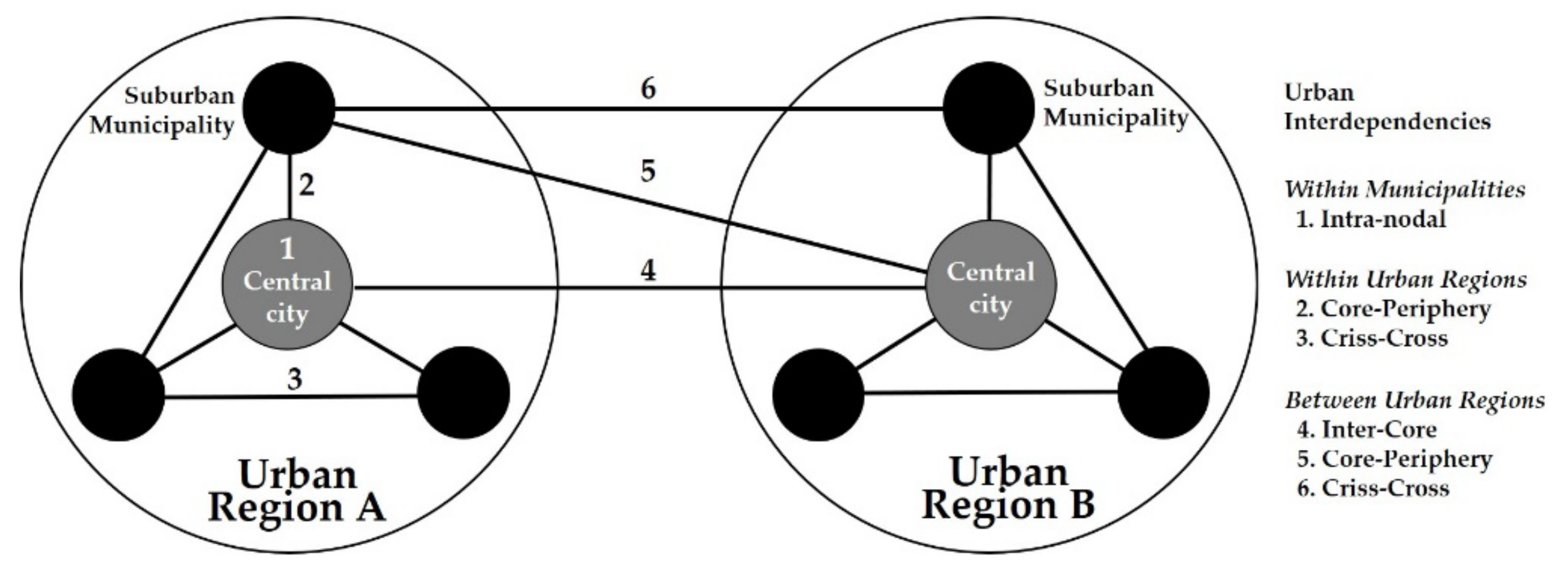


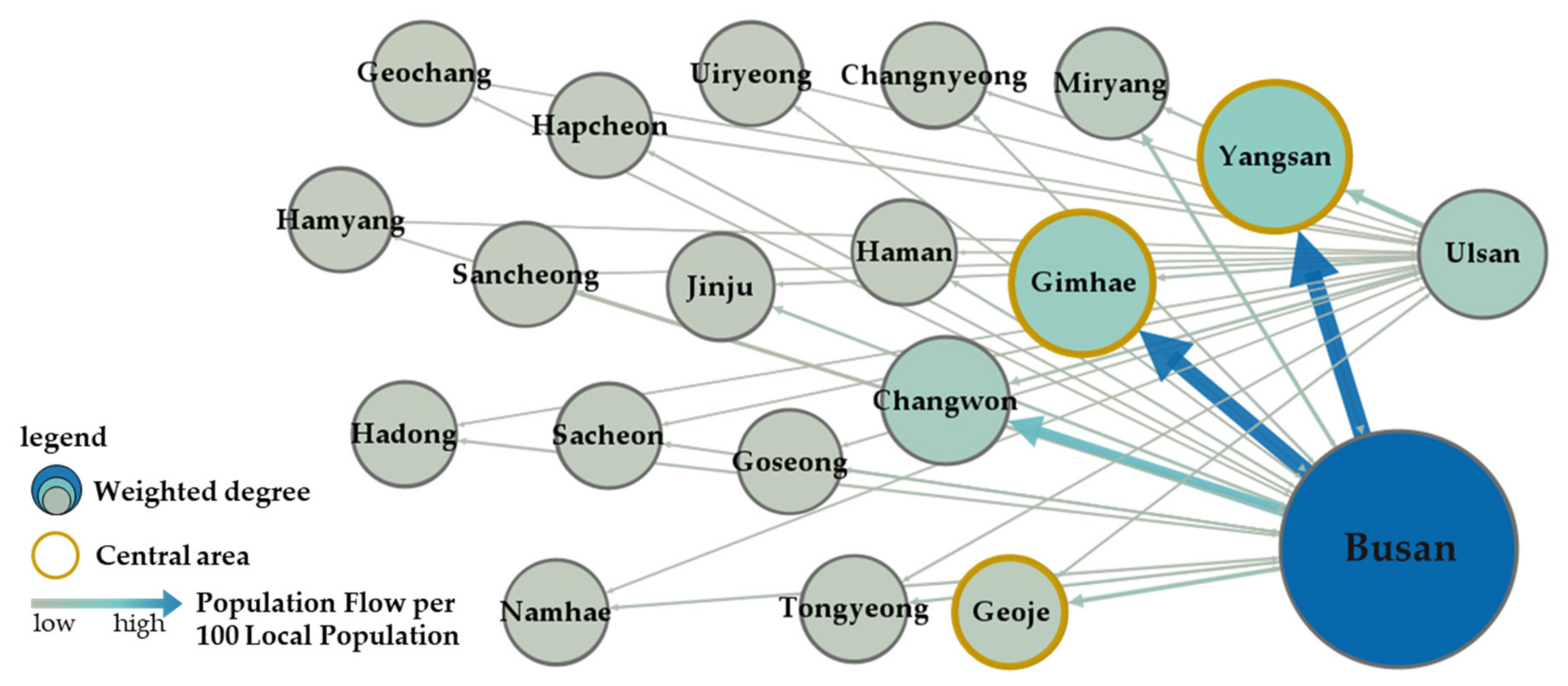
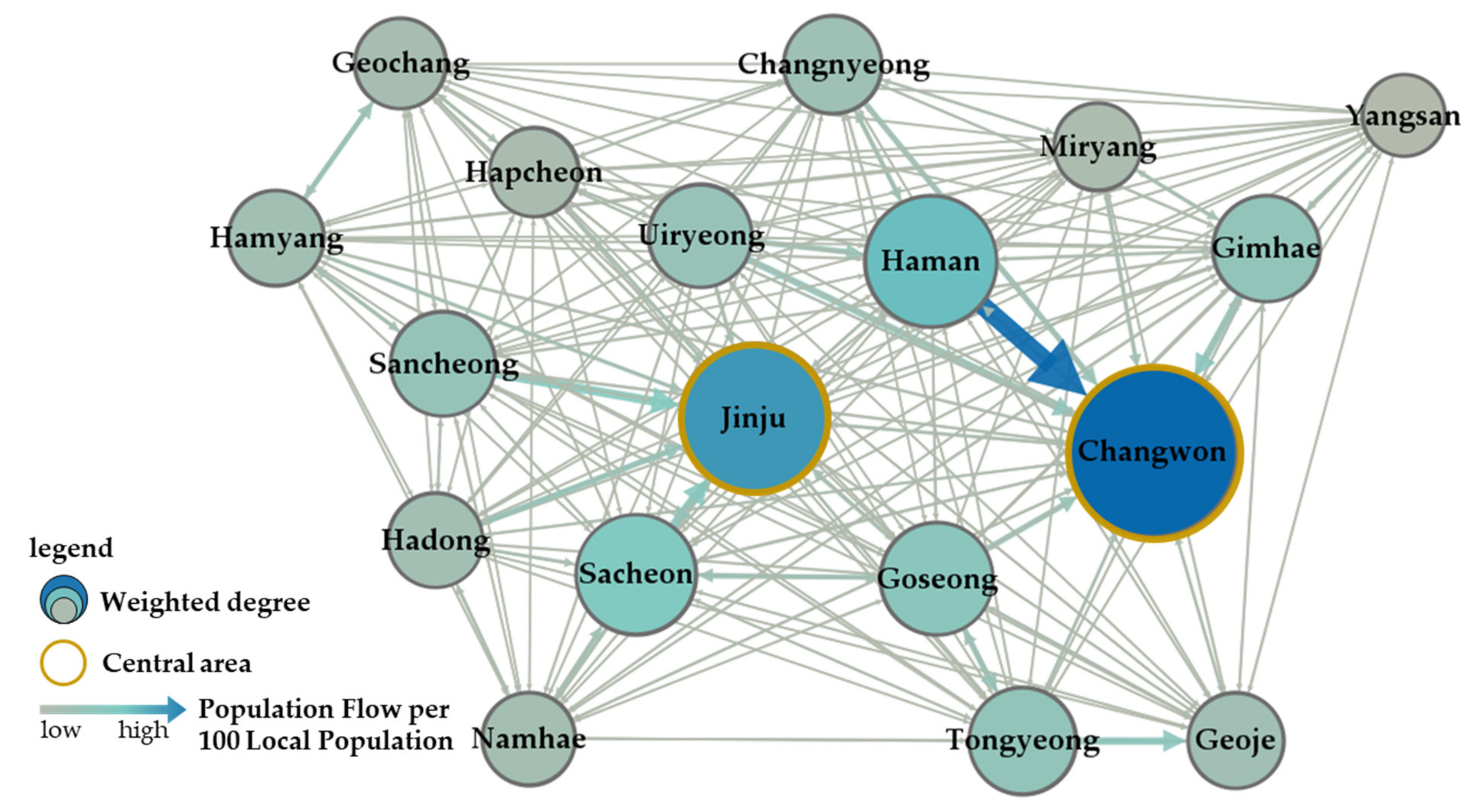

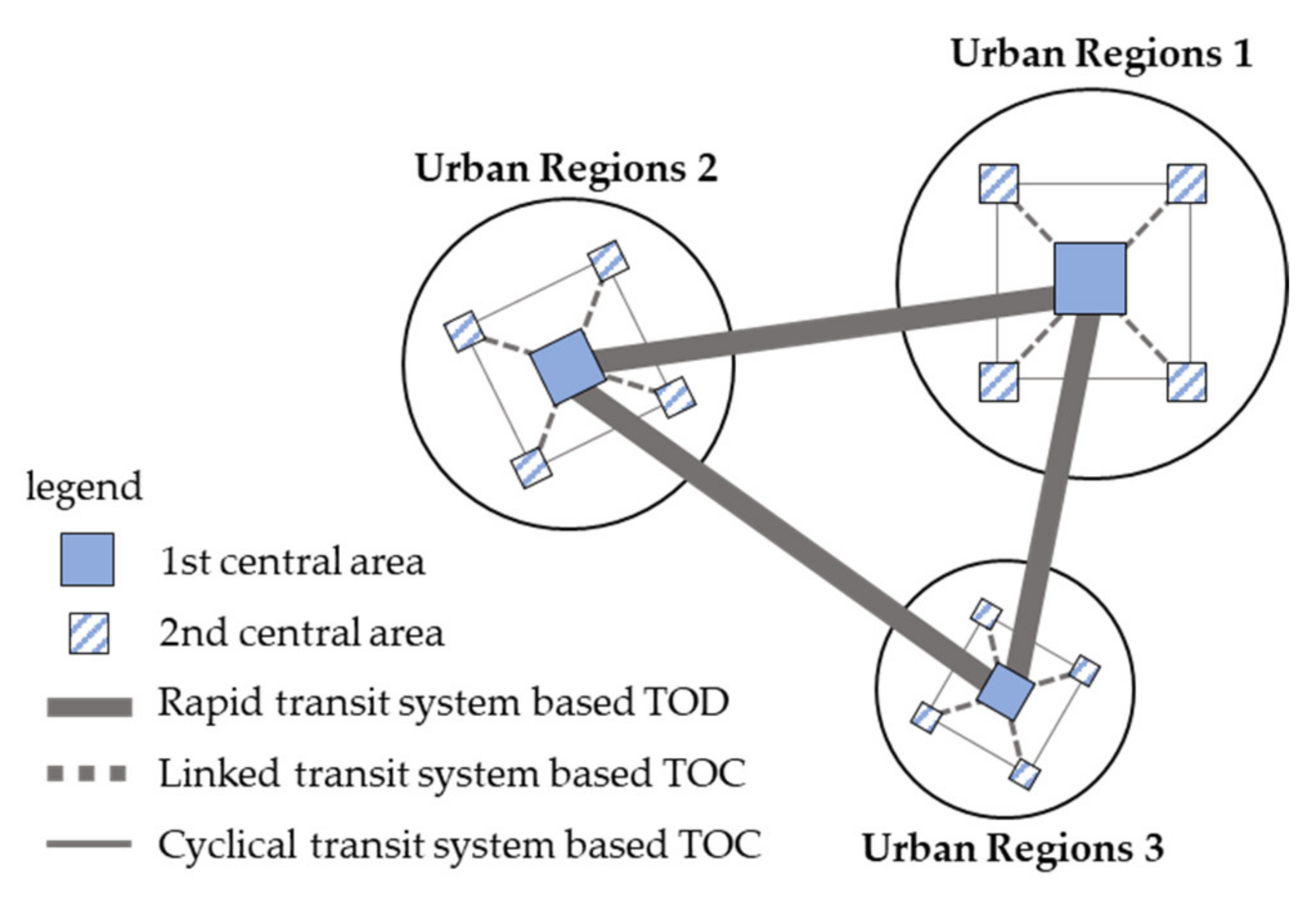
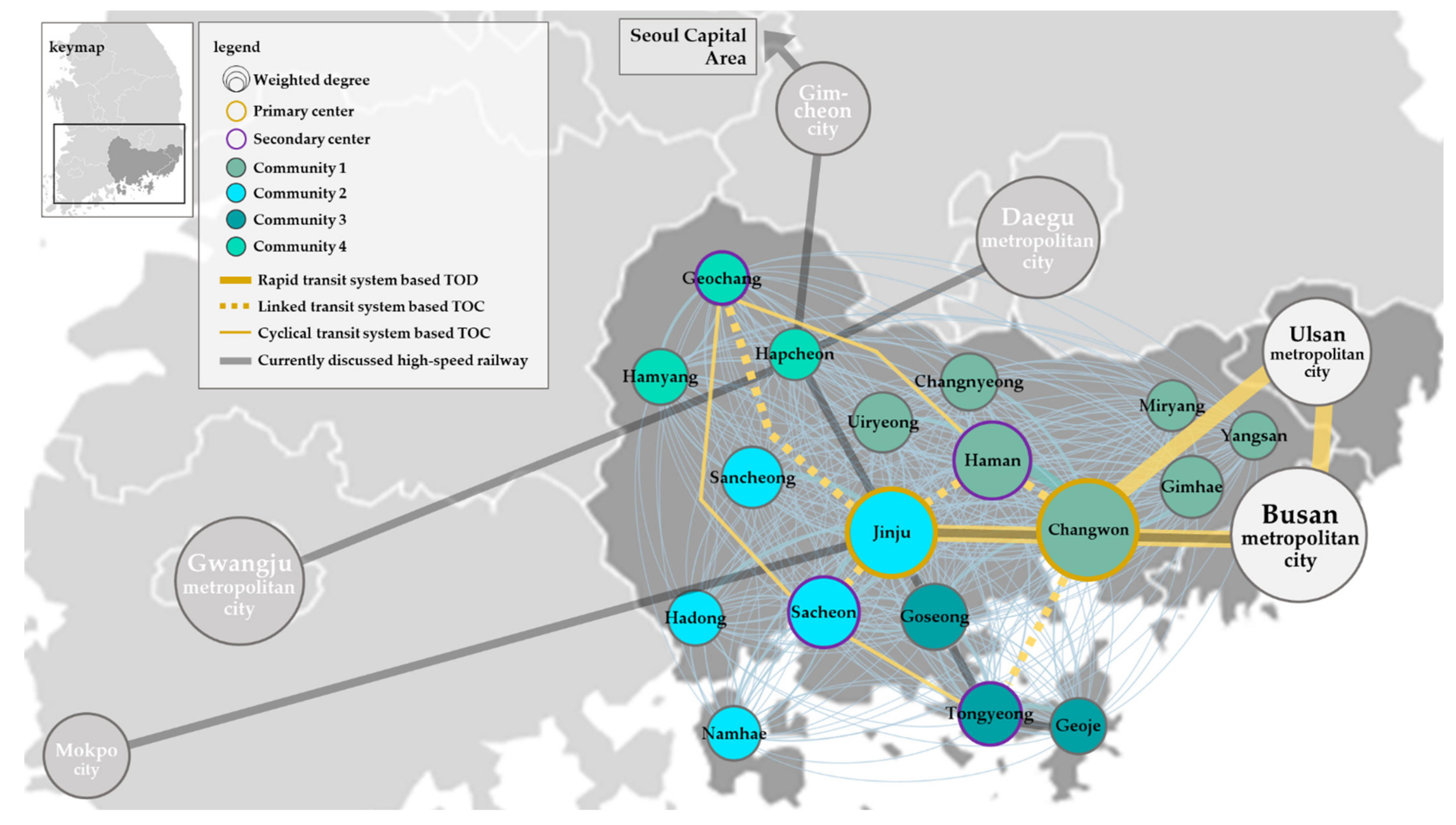
| Origin | Destination | |||
|---|---|---|---|---|
| No | SGP | Busan | Ulsan | |
| 1 | Yangsan | city (si) | 15.38 | 4.78 |
| 2 | Gimhae | city (si) | 11.57 | 0.59 |
| 3 | Miryang | city (si) | 4.90 | 0.97 |
| 4 | Geoje | city (si) | 4.05 | 0.39 |
| 5 | Changwon | city (si) | 3.94 | 0.32 |
| 6 | Uiryeong | county (gun) | 2.65 | 0.3 |
| 7 | Haman | county (gun) | 2.59 | 0.31 |
| 8 | Changnyeong | county (gun) | 2.40 | 0.28 |
| 9 | Namhae | county (gun) | 2.39 | 0.18 |
| 10 | Goseong | county (gun) | 2.33 | 0.33 |
| 11 | Tongyeong | city (si) | 2.02 | 0.2 |
| 12 | Hadong | county (gun) | 1.90 | 0.2 |
| 13 | Sancheong | county (gun) | 1.66 | 0.18 |
| 14 | Hapcheon | county (gun) | 1.62 | 0.2 |
| 15 | Sacheon | city (si) | 1.55 | 0.22 |
| 16 | Hamyang | county (gun) | 1.37 | 0.15 |
| 17 | Jinju | city (si) | 1.32 | 0.18 |
| 18 | Geochang | county (gun) | 0.92 | 0.19 |
| Origin | Destination | ||||||||
|---|---|---|---|---|---|---|---|---|---|
| Yangsan | Gimhae | Changwon | Geoje | Miryang | Jinju | Tongyeong | Haman | Sacheon | |
| City (si) | City (si) | City (si) | City (si) | City (si) | City (si) | City (si) | County (gun) | City (si) | |
| Busan | 221.87 | 216.52 | 131.74 | 42.91 | 34.96 | 21.22 | 18.28 | 11.57 | 10.84 |
| Ulsan | 57.10 | 16.15 | 21.33 | 8.58 | 11.75 | 6.07 | 5.43 | 2.30 | 3.04 |
| Origin | Destination | ||||||||
| Namhae | Changnyeong | Goseong | Hadong | Sancheong | Hapcheon | Uiryeong | Hamyang | Geochang | |
| County (gun) | County (gun) | County (gun) | County (gun) | County (gun) | County (gun) | County (gun) | County (gun) | County (gun) | |
| Busan | 10.40 | 10.04 | 8.83 | 8.35 | 6.67 | 5.87 | 5.66 | 4.05 | 3.80 |
| Ulsan | 2.59 | 2.18 | 2.23 | 2.12 | 1.85 | 1.81 | 0.84 | 1.25 | 1.50 |
| No | City/County | EC | City/County | FBC |
|---|---|---|---|---|
| 1 | Busan | 0.696 | Busan | 1393.92 |
| 2 | Yangsan | 0.464 | Ulsan | 235.70 |
| 3 | Gimhae | 0.439 | Yangsan | 76.32 |
| 4 | Changwon | 0.271 | Gimhae | 37.66 |
| 5 | Ulsan | 0.120 | Miryang | 25.42 |
| 6 | Geoje | 0.089 | Geoje | 18.93 |
| 7 | Miryang | 0.074 | Changwon | 13.74 |
| 8 | Jinju | 0.045 | Haman | 11.37 |
| 9 | Tongyeong | 0.038 | Goseong | 11.23 |
| … | … | … | ||
| 18 | Uiryeong | 0.012 | Hamyang | 6.05 |
| 19 | Hamyang | 0.009 | Uiryeong | 5.46 |
| 20 | Geochang | 0.008 | Geochang | 5.01 |
| Concentric map 1 | 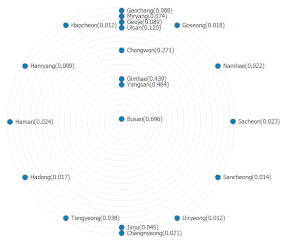 | 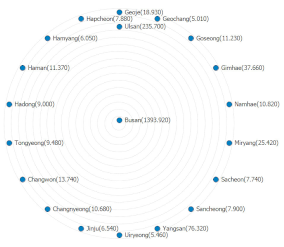 | ||
| OD | 1 | 2 | 3 | 4 | 5 | 6 | 7 | 8 | 9 | 10 | 11 | 12 | 13 | 14 | 15 | 16 | 17 | 18 |
|---|---|---|---|---|---|---|---|---|---|---|---|---|---|---|---|---|---|---|
| 1 | - | 365 | 5 | 10 | 69 | 8 | 3 | 223 | 3 | 33 | 29 | 71 | 4 | 10 | 5 | 11 | 40 | 16 |
| 2 | 46 | - | 5 | 30 | 205 | 42 | 8 | 165 | 5 | 8 | 48 | 33 | 9 | 18 | 9 | 24 | 24 | 17 |
| 3 | 9 | 45 | - | 6 | 17 | 5 | 5 | 5 | 189 | 112 | 53 | 4 | 5 | 14 | 26 | 9 | 3 | 7 |
| 4 | 4 | 96 | 3 | - | 36 | 41 | 8 | 6 | 4 | 3 | 42 | 5 | 7 | 17 | 8 | 152 | 2 | 16 |
| 5 | 20 | 509 | 3 | 25 | - | 13 | 7 | 24 | 4 | 6 | 26 | 69 | 7 | 12 | 6 | 15 | 7 | 65 |
| 6 | 7 | 365 | 4 | 81 | 48 | - | 11 | 20 | 9 | 4 | 195 | 5 | 15 | 268 | 11 | 358 | 6 | 13 |
| 7 | 3 | 75 | 4 | 13 | 25 | 14 | - | 11 | 8 | 4 | 379 | 3 | 102 | 121 | 49 | 11 | 5 | 11 |
| 8 | 181 | 1532 | 6 | 20 | 91 | 29 | 9 | - | 6 | 13 | 83 | 16 | 10 | 24 | 10 | 24 | 124 | 17 |
| 9 | 3 | 50 | 306 | 8 | 20 | 7 | 8 | 7 | - | 14 | 181 | 3 | 5 | 20 | 143 | 11 | 6 | 11 |
| 10 | 46 | 78 | 97 | 9 | 23 | 7 | 4 | 16 | 8 | - | 139 | 5 | 4 | 15 | 33 | 8 | 53 | 12 |
| 11 | 6 | 118 | 17 | 23 | 30 | 63 | 95 | 36 | 38 | 44 | - | 6 | 47 | 371 | 157 | 35 | 32 | 9 |
| 12 | 64 | 211 | 3 | 9 | 176 | 4 | 3 | 14 | 2 | 4 | 18 | - | 4 | 5 | 3 | 7 | 3 | 45 |
| 13 | 4 | 95 | 2 | 11 | 32 | 15 | 96 | 13 | 3 | 4 | 168 | 6 | - | 230 | 10 | 23 | 2 | 15 |
| 14 | 5 | 97 | 6 | 24 | 30 | 209 | 64 | 19 | 11 | 8 | 595 | 3 | 129 | - | 30 | 44 | 6 | 9 |
| 15 | 3 | 91 | 36 | 15 | 26 | 13 | 49 | 17 | 157 | 32 | 651 | 3 | 11 | 52 | - | 14 | 23 | 12 |
| 16 | 3 | 120 | 3 | 511 | 26 | 243 | 7 | 6 | 4 | 3 | 72 | 7 | 11 | 41 | 9 | - | 2 | 10 |
| 17 | 77 | 461 | 5 | 12 | 49 | 10 | 6 | 349 | 5 | 81 | 172 | 8 | 8 | 21 | 22 | 11 | - | 22 |
| 18 | 5 | 58 | 2 | 14 | 117 | 5 | 4 | 6 | 2 | 3 | 12 | 25 | 5 | 6 | 3 | 8 | 2 | - |
| No | City/County | EC | City/County | FBC |
|---|---|---|---|---|
| 1 | Changwon | 0.622 | Jinju | 21,839 |
| 2 | Haman | 0.541 | Changwon | 21,647 |
| 3 | Uiryeong | 0.263 | Tongyeong | 14,591 |
| 4 | Jinju | 0.216 | Sacheon | 13,678 |
| 5 | Gimhae | 0.213 | Goseong | 13,615 |
| 6 | Changnyeong | 0.192 | Haman | 12,012 |
| 7 | Goseong | 0.185 | Sancheong | 11,073 |
| 8 | Sacheon | 0.146 | Gimhae | 11,006 |
| 9 | Sancheong | 0.118 | Hamyang | 10,409 |
| … | … | … | ||
| 18 | Geochang | 0.040 | Yangsan | 3921 |
| 19 | Miryang | 0.096 | Hapcheon | 9485 |
| 20 | Hadong | 0.085 | Changnyeong | 9011 |
| Concentric map 1 | 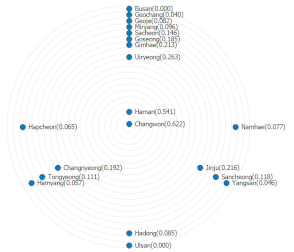 | 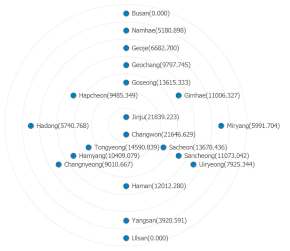 | ||
| Community | No | City/County | EC | FBC | Central Cities | |
|---|---|---|---|---|---|---|
| The First | The Second | |||||
| 1 | 1 | Changwon | 0.661 | 3178 | ∨ | |
| 2 | Haman | 0.609 | 2724 | ∨ | ||
| 3 | Changnyeong | 0.218 | 2023 | |||
| 4 | Gimhae | 0.229 | 1999 | |||
| 5 | Miryang | 0.108 | 1478 | |||
| 6 | Uiryeong | 0.282 | 961 | |||
| 7 | Yangsan | 0.046 | 691 | |||
| 2 | 1 | Jinju | 0.661 | 2220 | ∨ | |
| 2 | Sacheon | 0.466 | 1149 | ∨ | ||
| 3 | Hadong | 0.322 | 1043 | |||
| 4 | Namhae | 0.234 | 829 | |||
| 5 | Sancheong | 0.433 | 439 | |||
| 3 | 1 | Tongyeong | 0.685 | 0.685 | ∨ | |
| 2 | Geoje | 0.581 | 0.581 | |||
| 3 | Goseong | 0.440 | 0.440 | |||
| 4 | 1 | Geochang | 0.702 | 209 | ∨ | |
| 2 | Hamyang | 0.661 | 22 | |||
| 3 | Hapcheon | 0.265 | 22 | |||
Publisher’s Note: MDPI stays neutral with regard to jurisdictional claims in published maps and institutional affiliations. |
© 2022 by the authors. Licensee MDPI, Basel, Switzerland. This article is an open access article distributed under the terms and conditions of the Creative Commons Attribution (CC BY) license (https://creativecommons.org/licenses/by/4.0/).
Share and Cite
Baek, Y.; Joo, H. A Study on the Spatial Structure of the Bu-Ul-Gyeong Megacity Using the City Network Paradigm. Sustainability 2022, 14, 15845. https://doi.org/10.3390/su142315845
Baek Y, Joo H. A Study on the Spatial Structure of the Bu-Ul-Gyeong Megacity Using the City Network Paradigm. Sustainability. 2022; 14(23):15845. https://doi.org/10.3390/su142315845
Chicago/Turabian StyleBaek, Yoonjee, and Heesun Joo. 2022. "A Study on the Spatial Structure of the Bu-Ul-Gyeong Megacity Using the City Network Paradigm" Sustainability 14, no. 23: 15845. https://doi.org/10.3390/su142315845





